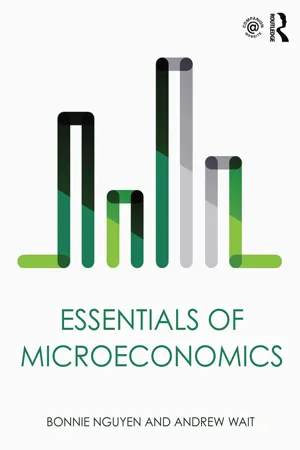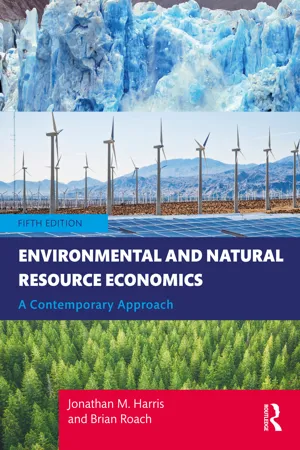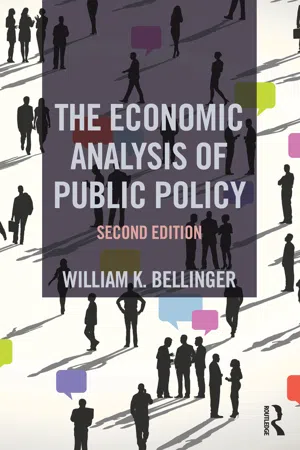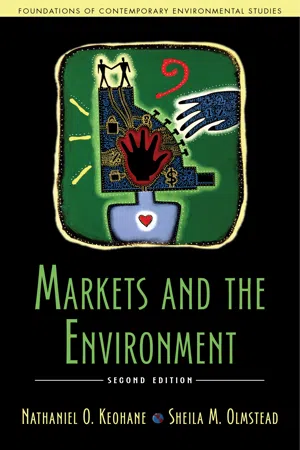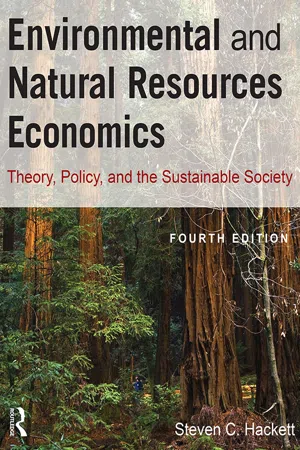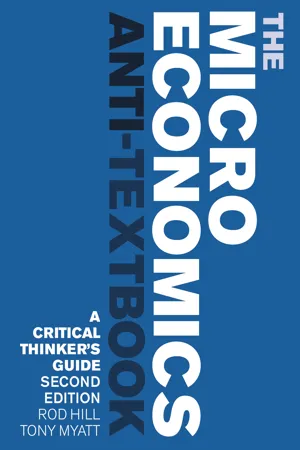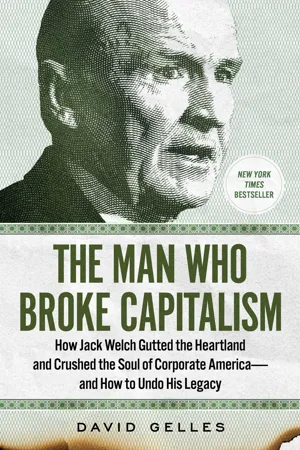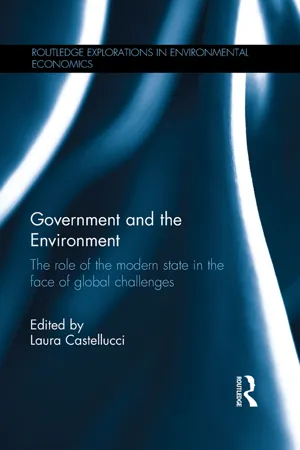Economics
Negative Externality
A negative externality occurs when the production or consumption of a good or service imposes costs on third parties who are not involved in the transaction. These costs are not reflected in the market price, leading to an inefficient allocation of resources. Examples include pollution from industrial production and noise from construction activities. Negative externalities can be addressed through government intervention or by internalizing the external costs.
Written by Perlego with AI-assistance
Related key terms
Related key terms
1 of 4
Related key terms
1 of 3
12 Key excerpts on "Negative Externality"
- eBook - ePub
Health Economics
Demystifying Healthcare Economics, Your Guide to Informed Decisions and a Healthier Future
- Fouad Sabry(Author)
- 2023(Publication Date)
- One Billion Knowledgeable(Publisher)
There are a variety of theoretical methods for enhancing social utility when negative externalities are present. The market-driven approach to correcting externalities involves "internalizing" third-party costs and benefits, such as requiring a polluter to repair any damage caused. However, internalizing costs or benefits is often impractical, particularly when the true monetary values cannot be determined.Externalities are not necessarily minor or local, despite the fact that laissez-faire economists such as Friedrich Hayek and Milton Friedman refer to them as "neighborhood effects" and "spillovers." Similarly, Ludwig von Mises argues that externalities result from the absence of a "clear definition of personal property."Externalities can arise between producers, consumers, and producers and consumers. Externalities can be negative when one party's action imposes costs on another or positive when one party's action results in benefits for another.Light pollution is an example of an externality because the consumption of street lighting has an effect on bystanders that is not compensated for by the consumers of the lighting.A Negative Externality (also known as "external cost" or "external diseconomy") is an economic activity that has a negative impact on an unrelated third party that is not reflected in the market price. It can occur during either the production or consumption of a product or service. Barry Commoner commented on externality costs:Clearly, we have compiled a list of significant technological failures in recent interactions with the environment. In each instance, the new technology was implemented before the ultimate risks were identified. We were quick to reap the benefits but sluggish to comprehend the costs.Numerous negative externalities are associated with the environmental impacts of production and consumption. The article on environmental economics also discusses externalities and how to address them in the context of environmental issues. - No longer available |Learn more
- Bonnie Nguyen, Andrew Wait(Authors)
- 2015(Publication Date)
- Routledge(Publisher)
17 ExternalitiesDOI: 10.4324/9781315690339-1717.1 Introduction
As we have seen in previous chapters, competitive markets are usually Pareto efficient. This is because all mutually beneficial trades1 occur, maximizing the gains from trade and hence total surplus. However, there are some situations where the market outcome will not be efficient; these are called market failures.This chapter examines one type of market failure: externalities. An externality is a cost or benefit that accrues to a person who is not directly involved in an economic activity or transaction. The presence of an externality means that the market outcome may not be efficient, because the market does not take into account these external costs and benefits of producing or consuming a product. This means that a competitive market can end up producing too much of a product (with a Negative Externality) or too little (when there are external benefits).We begin with a discussion of the nature of and the market failure associated with externalities, and then turn to several possible solutions to this market failure.17.2 External costs and benefits
An externality is a cost or benefit of an economic activity that accrues to a person not directly involved in that activity.2 These costs or benefits are also known as ‘external costs’ or ‘external benefits’.- A positive externality occurs when the economic activity results in external benefits for a third party. For example, if a student decides to pursue further education, there may be benefits to society as a whole from having better-educated citizens, in addition to the individual benefits that are enjoyed by the student themselves.
- A Negative Externality
- eBook - ePub
Environmental and Natural Resource Economics
A Contemporary Approach
- Jonathan M. Harris, Brian Roach(Authors)
- 2021(Publication Date)
- Routledge(Publisher)
Chapter 3
The Theory of Environmental Externalities
DOI: 10.4324/9781003080640-3Chapter 3 Focus Questions
- How can pollution and environmental damage be represented in economics?
- What economic policies can be instituted to respond to environmental problems?
- How and when can property rights be relied upon to solve environmental problems?
3.1 The Theory of Externalities
We saw in Chapter 1 that one of the core concepts of environmental economics is the theory of environmental externalities. Externalities were defined as impacts that affect the well-being of those outside of a market transaction. Externalities can be either positive or negative. The most common example of aNegative Externalityis pollution. If markets operate without any regulation, the production decisions of companies will not account for the social and ecological damages of pollution. Consumers also typically will not limit their purchases because of pollution caused by various goods and services. But comprehensive economic analysis considers not just the ways markets impact buyers and sellers, but how markets affect all members of society. (It may also be relevant to consider impacts on nonhuman species and on ecosystems in general—this issue will be dealt later in this chapter and also in Chapters 6 and 7 .) So when we analyze the overall impacts of a market, we need to account for the damages from pollution and other negative environmental impacts.- Negative Externality negative impacts of a market transaction affecting those not involved in the transaction.
In some cases, a market transaction can generate a positive externality - eBook - ePub
The Economics of Property and Planning
Future Value
- Graham Squires(Author)
- 2021(Publication Date)
- Routledge(Publisher)
It is worth here, explaining in more depth what externalities are and how they feature within property and planning. Externalities can be more broadly defined as the spill-over or third-party effects arising from the production and/or consumption of goods and services in the marketplace. Transactions within the market will generate costs and benefits that are external to those producing and consuming goods and services. For instance, a supplier (e.g. a construction company) provides for purchase on the market a number of buy-to-let residential properties within a city neighbourhood. In this transaction, a building supplier will sell these units at the maximum possible price assuming the seller is rational and wealth maximising. Similarly, the buyers (the new landlords) in the transaction will pay for the units at the lowest possible price negotiated, again this is assuming that the buyers are wealth maximising and rational. Under normal circumstances, there will be benefits gained by both parties, although a transaction may be at a loss under certain circumstances such as if there needs to be a quick sale or if the market price for residential property is falling.What is not factored in within this market transaction what the external costs and benefits for those other households in the neighbourhood that will interact and gain satisfaction in proximity to the new dwellings. As examples in this case of negative externalities, there could be the problems (e.g. noise, fly-tipping, poor maintenance) of transient families in buy-to-let properties that have no long-term stake in the neighbourhood. Poor upkeep of homes by residents with no incentive to ‘keep up appearances’ may in turn devalue the neighbourhood. It is this fall in value that is not internalised in the original market value and hence considered as having a measurable external cost, referred to in short as an externality.Externalities can be positive and/or negative with a third party spill-over effect generating benefits as well as costs. In using the housing market example, a positive externality could be if the buy-to-let properties were providing a new higher income demographic of resident to a neighbourhood that was depopulating and of low value (the situation where gentrification would be welcomed). The introduction of a new incoming group of residents to a neighbourhood that was depopulating or was suffering problems of large-scale concentrated mono-tenure (e.g. social housing) may provide some external benefits. For instance, the spill-over effects of increased population and increased disposable income in a struggling neighbourhood will enable local services to continue to have a demand. Furthermore, the introduction of a tenure mix will encourage the development of a mixed community that will provide opportunities for greater social cohesion and reduce social polarisation of communities in neighbourhoods. - eBook - ePub
- William K. Bellinger(Author)
- 2015(Publication Date)
- Routledge(Publisher)
Chapter 3 , including that of Robert Nozick.In conclusion, misleading the consumer is inefficient as well as unethical. As seen in Table 4.3 , the difference between the net gains with perfect information and imperfect information equals the negative of area E, which is the deadweight loss caused by imperfect information. This triangle (area E) provides a good example of the typical deadweight loss from overproduction, a triangle that points leftward toward the competitive equilibrium point.Externalities
Pollution flowing from an auto factory can harm people who have nothing to do with the production or consumption of cars. Similarly, the beauty of a well-designed building can provide pleasure to passersby who neither work nor shop in the building. These negative or positive effects of markets on uninvolved parties are called externalities. An externality is a cost or benefit to a party not involved in the production or consumption of the good. In that sense, those experiencing external costs or benefits are outside of the market process, and generally will not be considered in the decisions of self-interested buyers or sellers. As noted earlier, a basic reason why some costs and benefits are external to the market is the lack of defined property rights. For example, in many cases, nobody owns the air or water into which pollutants are dumped. Therefore, nobody can charge for the use of the air or the water for waste, despite the real costs such use can bring. Externalities are analyzed in greater detail in Chapters 12 and 13 , which cover urban transportation and pollution policy, and those discussions depend on a clear understanding of the following concepts.Externalities can be harmful or helpful. For example, water pollution produced by farmers may negatively affect their neighbors or cities downstream. On the other hand, visitors to Hershey, Pennsylvania, are likely to enjoy the aroma rising from the chocolate factory near the center of town. Another example of a positive externality is the more familiar case of the beekeeper and the apple orchard. A beekeeper’s insects will provide great benefits to an orchard located next door through the pollination of its trees. This will happen whether or not the orchard owner pays for this benefit. Therefore, the pollination process is basically external, as are the benefits of pollination to the orchard owner. Of course, the beekeeper will experience a similar benefit from the apple orchard, a source of nectar for the bees. - eBook - ePub
- Nathaniel O. Keohane, Sheila M. Olmstead(Authors)
- 2016(Publication Date)
- Island Press(Publisher)
1 We call it a tragedy because everyone would be better off if they could all commit themselves to act less selfishly. Thus, individually rational actions add up to a socially undesirable outcome.In this chapter, we examine each of these three problems in turn. We demonstrate why markets fail to be efficient in each case. We also show how these seemingly distinct categories of environmental problems are linked at a fundamental level. You may already see the deep similarities between them. For example, air quality can be described in terms of a Negative Externality (your automobile exhaust makes my air worse), as a public good (clean air is enjoyed by all, so individuals have too little incentive to provide it), or as a commons problem (each driver overuses the shared atmospheric commons). Similarly, overfishing problems, though typically couched in the language of the tragedy of the commons, can also be described as a Negative Externality or as a free rider problem.ExternalitiesWe gave an intuitive definition of a Negative Externality earlier, in the example of automobile emissions. More generally, we can define an externality as follows:2An externality results when the actions of one individual (or firm) have a direct, unintentional, and uncompensated effect on the well-being of other individuals or the profits of other firms.Note three keywords in the definition: direct, unintentional, and uncompensated. For example, because your health and happiness depend in part on how clean the air is, automobile drivers have a direct effect on your well-being. Unintentional is included in the definition to rule out acts of spite or malice. (It is the effect rather than the action that is unintentional. I may decide deliberately to use a gasoline-powered lawnmower, without the intent of my action being to pollute the air or disturb the neighbors.) Finally, uncompensated - eBook - ePub
- Raghbendra Jha(Author)
- 2009(Publication Date)
- Routledge(Publisher)
4 External effects and the market mechanism DOI: 10.4324/9780203870044-4 Key concepts: externalities; market failure; the Coase solution; Pigovian taxation and subsidization; conditional perfect price discrimination; conditional perfect internalization; common property resources; multilateral externalities 4.1 Introduction In Part I we have examined the circumstances under which the market mechanism works efficiently. More specifically the second classical theorem of welfare economics, which was proved in Chapter 2, delineates these conditions. If such conditions did indeed obtain there would be no reason for government intervention in the working of the market mechanism. We realize, of course, that the conditions of this theorem are very stringent. In this chapter we relax one of these conditions and examine the implications for public policy. It has been implicit in our analysis so far that the preference ordering of any consumer is defined over her own consumption set. Similarly it has been assumed that the production set of any producer is independent of the production sets of other producers and consumption sets of consumers. In real life these assumptions are often violated and we have interdependence between production and/or consumption sets. When this occurs, an externality is said to exist. Formally, then, an externality is a commodity which is produced during the production and/or consumption of other goods and which affects other producers/consumers. When a paper mill dumps toxic waste into a river, thus contaminating the fish downstream, it affects the production sets of fishermen living downstream. When your neighbor plays loud music late at night when you are trying to sleep, he affects your consumption set and welfare - eBook - ePub
Environmental and Natural Resources Economics
Theory, Policy, and the Sustainable Society
- Steven Hackett, Sahan T. M. Dissanayake(Authors)
- 2014(Publication Date)
- Routledge(Publisher)
- While the legal system is designed to protect property, open-access and public trust resources were not traditionally protected under common law from pollution harms and thus remain subject to degradation. The legal system does not function perfectly, of course, and so pollution harms to people, their homes, and other valuable objects that are property do regularly occur. One problem is in determining the source of the pollution when there may be very large numbers of emitters, as is the case with automobile exhaust.
- Negative externalities are uncompensated damage costs borne by members of society. These negative externalities are generated as a by-product of production and exchange. Profit-maximizing firms have an incentive to transform private costs into negative externalities (external costs) in the absence of regulation or reputation effects. When there are important negative externalities, market supply based on private costs to sellers is too large, leading to too much of the good or service generating the negative externalities being produced in otherwise well-functioning competitive markets. Pigouvian taxes represent a form of policy intervention that can enhance market efficiency.
- In the real world, it is difficult to craft Pigouvian taxes due to (a) practical problems measuring marginal external costs without controversy, and (b) the influence of rival interest groups and political expediency in the policymaking process.
Review Questions and Problems
-
Suppose that there are 100 identical competitive firms, each of which supplies a quantity where price equals marginal cost. Therefore, if marginal cost is 10 + Q, each individual firm’s supply curve is given by P = 10 + Q. As there are 100 such firms, the market supply curve is P = 10 + .01Q. Also assume that market demand is given by P = 100 ‒ .005Q. Note that Q refers to the quantity of some good, like shoes.
- Solve for the competitive market equilibrium price and quantity.
- Suppose now that in Review Problem 1a, firms were freely polluting by emitting marginal external costs equal to a constant $20 for each unit of output produced. Based on this information, we know that each firm’s social-cost supply curve is given by P = 30 + Q, and the social-cost market supply is given by the function P = 30 + .01Q
- eBook - ePub
The Microeconomics Anti-Textbook
A Critical Thinker's Guide - second edition
- Rod Hill, Tony Myatt(Authors)
- 2021(Publication Date)
- Zed Books(Publisher)
The most obvious examples where both consumers and producers have been failing to pay the full social costs are the activities that contribute to climate change. The standard texts typically mention this issue in their chapter on externalities. Because of its critical importance, a Postscript chapter is devoted to this, examining the content of the texts and providing an anti-text critique. Unfortunately, as we will see, there is no shortage of other pervasive and serious externalities to consider.Included in this chapter are two other kinds of goods. External costs play a central role in the analysis of ‘common access resources’ such as water or wild fish, where people using the resource impose costs on others. The concepts of external benefits and costs also appear when considering ‘public goods’ (or ‘public bads’) to which everyone has free access and where no one’s use of the good (or bad) reduces others’ ability to consume it – for example, a quiet (or an unpleasantly noisy) street.1 The Standard Text1.1 ExternalitiesSuppose that you’re making a decision about how much to drive your car in a week. You weigh the benefits to you of doing various things (going to work, shopping and so on) against the costs you have to pay: fuel, and wear and tear on your car, for example.The result of this rational choice is illustrated in Figure 7.1 - eBook - ePub
The Man Who Broke Capitalism
How Jack Welch Gutted the Heartland, Widened the Wealth Gap, and Crushed the Soul of Corporate America—and How to Undo His Legacy
- David Gelles(Author)
- 2022(Publication Date)
- Simon & Schuster(Publisher)
Negative Externalities“We’re not treated as human beings”
Arthur Cecil Pigou, contemplating the trajectory of modern capitalism a century ago, foresaw what was to come. Pigou, an English economist who worked as a professor at the University of Cambridge, was concerned not just with how goods and services changed hands, but also with what effect all that economic activity had on society at large. In 1920, he published his seminal work, The Economics of Welfare, putting his finger on a core truth about capitalism that was as resonant then as it is today: individuals running corporations are incentivized to maximize their own self-interest, not take care of the rest of the world. The Economics of Welfare also expanded on the concept of “externalities” in business, a term for the side effects of commercial activity. Where previous economists had mostly considered the positive externalities of a growing economy—the cost of goods going down as supply increased, for example—Pigou turned his attention to negative externalities: all the harm that companies might cause in their pursuit of profits. If industrialists couldn’t be trusted to look out for the common good, Pigou understood, it was only a matter of time before the consequences of their actions began to spill over into the wider world. In his book, Pigou identified a handful of obvious negative externalities that were already clear to see, among them pollution in London. (He concluded that chimney smoke was obscuring a great deal of sunlight.) And he proposed some obvious solutions, including regulation and taxation, that might create disincentives for companies to run roughshod over their communities.Yet on his leafy Cambridge campus a hundred years ago, Pigou could not have imagined the great variety, scale, and impact of the harms that would be arising from the business world today. From runaway climate change to steep inequality, to hollowed-out communities abandoned by companies seeking cheap labor elsewhere, it can at times seem like corporations do as much harm as they do good. These are the negative externalities we now live with, and while Pigou may not have been able to articulate the specifics a century ago, he knew what was coming. - eBook - ePub
- Laura Castellucci(Author)
- 2014(Publication Date)
- Routledge(Publisher)
In the perspective of this book public goods stand for the public interests shared by the members of a political community, and exist independently of the simultaneous existence of the rival interests forming the texture of the commercial economy. Externalities are instead by their very nature a peculiar pathology, in fact the main pathology, of the commercial economy, which they need for their existence because it is in the commercial economy that rival interests are satisfied through exchange transactions between individual agents. At the same time, if we consider in particular the negative externalities lumped together in the general denomination of environmental pollution, they can for all purposes be treated as negative public goods, or public bads. It is precisely because of this peculiar combination of kinship/difference with public goods that externalities call for a special role of public policies and more generally government enforced cooperation to prevent the commercial society from collapsing under its internal, structural and sometimes ruinous dysfunctions. We use now Figure 3.1, drawn for an economy of two people, A and B, two goods, Y (numeraire) and Q, and a negative consumption externality caused by Q, to provide intuitive explanations/interpretations of: (i) the two types of inefficiency associated with a non-externality-based price system in the presence of externalities, (ii) the efficiency conditions, and (iii) the sheer complexity of an ideal externality-based price system aimed at ensuring a gravitation towards efficiency, through full internalization of the externality. (i) Consider point 1, with quantity Q 1 and price P 1. The figure shows neatly where the two types of inefficiency lie. One is the excessive total amount of Q. According to eq (10) efficiency is at point 3, with Q * < Q 1, and the welfare loss is measured by the shaded area 1–3–4. The other is the inefficient distribution of Q 1 among the two consumers - Joseph Berechman(Author)
- 2010(Publication Date)
- Routledge(Publisher)
12 Environmental and Safety Externalities1. INTRODUCTION
The growing literature on transportation, the environment, and safety attests to the importance that transportation professionals and decision makers—as well as the public at large—ascribe to these issues. The reasons are quite obvious: The impact of environmental degradation, global warming, and air and water pollution on health, together with the human and economic costs of accidents, have all achieved prominence on the public agenda. Moreover, it is universally recognized that transportation is a major contributor to these maladies.The economic literature treats these effects as negative externalities generated during the production and consumption of transportation outputs—individual travel and the transport of people and goods. They are regarded as externalities because producers and users do not take them into account when making transportation decisions, nor do they directly pay for the costs these phenomena impose. Instead, society at large bears these costs. To illustrate the magnitude of these effects, the external costs of transport in the European Union (EU) were estimated at about 8% of GDP in 1995 (INFRAS/IWW, 2000). Of all possible externalities, accidents, noise, air pollution, and climate change were the main contributors to these costs. Car use captured the largest share of externalities (58%), followed by heavyduty vehicles (21%). Road transport as a whole accounted for 92% versus rail and water transport, which contributed to the remainder. The combined results of these externalities were increased health care expenditures in addition to economic losses in terms of labor absenteeism, material damage, and wasted and lost natural resources.
Index pages curate the most relevant extracts from our library of academic textbooks. They’ve been created using an in-house natural language model (NLM), each adding context and meaning to key research topics.
Explore more topic indexes
Explore more topic indexes
1 of 6
Explore more topic indexes
1 of 4

